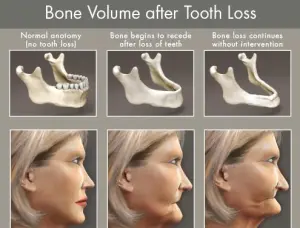If you lose a tooth, you can always get a dental implant. However, it is important to be in good health since your medical condition will determine if the dental implant is right for you or not. For instance, smoking, alcoholism, uncontrolled diabetes, or uncontrolled gum disease might affect the placing of the dental implant. It is, therefore, important to tell your dentist all your medical conditions before you do the surgeries.
A detailed assessment of overall stomata- gnathic system where your teeth functions will determine how and where the implants will be placed must be carried out. This will include the compilation of study models, the X-rays, and CT (computerized tomograms) scans. Planning using computer imaging will ensure that the dental implant is in the exact position in the bone.
Why and How the Bone Is Lost After Teeth Are Lost

A bone requires stimulation so that it can maintain its density and form. For the sac-like (alveolar) bone which offers support and surrounds the teeth, the teeth offer the necessary stimulation. After a tooth is lost, there will be less stimulation hence the alveoli bone is lost. When a tooth is lost, the breadth and the height of its bone decreases with years.
If more teeth are lost, there could be greater function loss. This causes function and aesthetic problems especially to people who have lost all their teeth. After the loss of the alveoli bone, the jawbone also starts to reabsorb.
How to Regrow or Preserve the Bone So That It Can Support the Dental Implant
Grafting the bone in the extraction sockets after tooth removal or tooth loss could help in preserving the bone that will be needed for implant placement. There are also surgical techniques that are used in regenerating a lost bone so that the implant can have the necessary bone substance to anchor it.
The bone has to be stimulated to stay healthy. Since the dental implants fuse into the bone, they usually stabilize it and prevent much bone loss. Reabsorption is an inevitable and normal process whereby the bone is lost if it is no longer connected or supported by the teeth. The dental implants always preserve and stops further bone loss.
How and Who Places the Dental Implants
Dental implant restoration or placement involves assessment and planning of the whole dental team. The dental team includes the oral surgeon, periodontist (the dental surgical specialist), a restorative dentist who deals with planning and restoration of the teeth, the general dentist with advanced surgery training and a dental laboratory technician. A surgical guide is typically used when placing the dental implants using surgical procedures. The implants are then placed in the sites so as to make intimate contact with the jawbone.
Options Available For the Implant Tooth Replacement.
A Single Tooth Replacement
 It may be placed immediately or after the healing period. The abutment is placed into the implant. It will hold the artificial crown. The custom made abutment will be screwed or cemented to the abutment so as to permanently fit it in place.
It may be placed immediately or after the healing period. The abutment is placed into the implant. It will hold the artificial crown. The custom made abutment will be screwed or cemented to the abutment so as to permanently fit it in place.
Multiple Fixed Tooth Replacement
In this, the abutments or the healing caps are placed on the multiple implants until the healing period is complete. Permanent abutments are then attached to the implants after healing. Finally, the custom-made bridge that will replace the multiple teeth will be screwed or cemented into the abutments.
The Removable Implant Supported Tooth Replacement.
Two to six implants can be used in supporting the lower denture if all the lower teeth are missing. If the upper teeth are missing, four implants should be used in supporting the dentures. Removable dentures are mostly used in replacing an extensive tooth, gum tissue or bone loss. This provides support to the facial skeleton, cheeks and lip. The new denture may have attachments that clip or snap it in place on your implant. A milled bar or a custom made one can be used to give additional strength required for restoration. Designs vary on the basis of the number of implants and your bone density.
How to Maintain the Dental Implants
Practicing good oral hygiene through flossing and brushing is important in controlling bacterial biofilms. Visiting your dental hygienist and the dentist is also important. They will use a special instrument in cleaning the dental implants to ensure that the metal surface beneath your gum tissue is not damaged. They will also provide the bridgework, implant crowns and dentures are functioning well.
If you use the screw retained bridge, the healing cap will be removed then the permanent abutment is screwed in the implant. The temporary bridge will later be replaced by a permanent one after you have tried the framework and it has fitted well. The dentist will then complete the bridge and place it in your mouth.
Welcome to CK Farr Dentistry – Your Trusted Atascadero Dental Office

Atascadero Dental Office Hours
We are closed daily from 1:00 PM – 2:00 PM for lunch.
Dental Office in Atascadero
